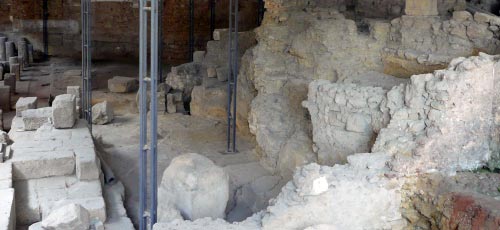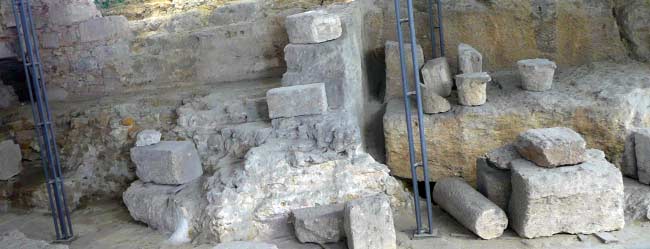LisbonLisboaPortugal.com
The best independent guide to Lisbon
LisbonLisboaPortugal.com
The best independent guide to Lisbon
Roman Amphitheatre, Lisbon
The only example of a Roman amphitheatre in Portugal is a ruin, buried under generations of dwellings. Lisbon’s amphitheatre has been partially excavated but it does require a stretch of the imagination to envisage the 5000 spectators cheering on a gladiator fighting for his life against a wild North African animal.
The roman amphitheatre was constructed overlooking the mouth of the Rio Tejo (River Tagus) close to the summit where the Castelo de São Jorge now stands. By carefully archaeological investigations it has been determined that the amphitheatre had a split level, with the stands encircling 3 quarters looking out to Rio Tejo to the south.
Roman Amphitheatre Lisbon Tourist Guide
The present day site is no more than a large excavation site with many of the main columns and sculptures uncovered in the Museu do Teatro Romano, so that is visible are a few large stone walls and part of the main arena floor.

The remains of the Roman Amphitheatre in Lisbon
The excavation is covered by a semi permanent roof to shield the site from the intensity of the sun but there are no intricate tiles or patterns. Lisbon's Roman Amphitheatre is free to visit and is located close to the Sé Cathedral and the main tram route through Alfama.
The Museu do Teatro Romano, displays items discovered at the excavation site and include an inscription dedicating the theatre to Emperor Nero and a statue of Silenus. The Museu do Teatro Romano is opposite the main Roman Amphitheatre and is housed in a seventeenth century building. Opening times are 10:00 to 13:00 and from 14:00 to 18:00 Tuesday to Sunday and Admission is free.
Roman Amphitheatre Lisbon History
The original amphitheatre was constructed by Emperor Augustus in 10BC, as the importance of Lisbon grew in the Roman Empire the amphitheatre was expanded in 57 AD to a standing capacity of 5000. The expansion was performed as a tribute to Emperor Nero, by order of Caius Heius Primus the high priest of the emperor’s cult. The first steps of the Amphitheatre were for the knights, being followed by the soldiers and civil servants. The middle part of the area was occupied by settlers and citizens of Lisbon.

Roman remains in Lisbon
On the steps at the upper levels sat successively freed the slaves who had to stand and, finally, in the covered porch, women. As the Roman Empire waned the amphitheatre was disused approximately the fourth century and later the large stones were used for building materials as Lisbon rapidly grew. The entire complex was completely covered by fallen rubble during the 1755 earthquake. The ruins were discovered in 1964 and a permanent excavation was started in 1980.
How about a small group tour?
One of the best ways to discover Lisbon and to meet fellow travellers is to join a guided tour. We have worked with Getyourguide.com for the last six years, and some of the best tours of Lisbon include:
Discover more of Lisbon with our most popular guides
If you've found our content valuable, we'd welcome your support.
The digital publishing landscape has evolved significantly. As a small independent publisher, we face growing challenges. Search engines increasingly favour paid content over organic results, while AI-generated content often reproduces original work without attribution.
To support our work, please consider bookmarking this page (press Ctrl + D) for quick access. If you find an article helpful, we'd be grateful if you'd share it with friends on social media.
For specific questions, please see our Reddit community at r/LisbonPortugalTravel.
Should you notice any outdated or incorrect information, please contact us at [email protected]
Thank you for helping us continue to provide valuable content in an increasingly challenging digital environment.
A complete list of all of our Lisbon articles
If you've found our content valuable, we'd welcome your support.
The digital publishing landscape has evolved significantly. As a small independent publisher, we face growing challenges. Search engines increasingly favour paid content over organic results, while AI-generated content often reproduces original work without attribution.
To support our work, please consider bookmarking this page (press Ctrl + D) for quick access. If you find an article helpful, we'd be grateful if you'd share it with friends on social media.
For specific questions, please see our Reddit community at r/LisbonPortugalTravel.
Should you notice any outdated or incorrect information, please contact us at [email protected]
Thank you for helping us continue to provide valuable content in an increasingly challenging digital environment.































